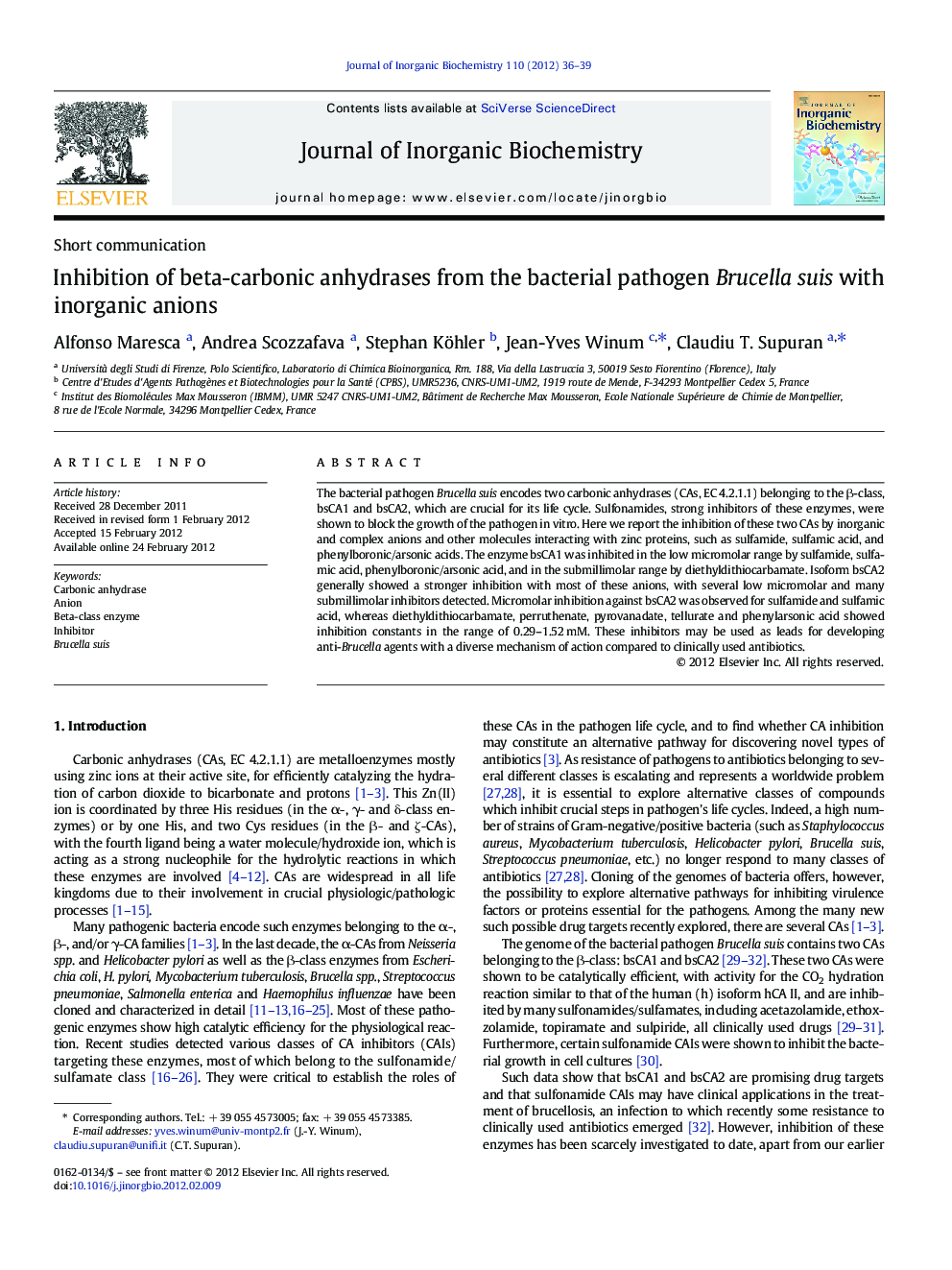| کد مقاله | کد نشریه | سال انتشار | مقاله انگلیسی | نسخه تمام متن |
|---|---|---|---|---|
| 1316520 | 1499477 | 2012 | 4 صفحه PDF | دانلود رایگان |

The bacterial pathogen Brucella suis encodes two carbonic anhydrases (CAs, EC 4.2.1.1) belonging to the β-class, bsCA1 and bsCA2, which are crucial for its life cycle. Sulfonamides, strong inhibitors of these enzymes, were shown to block the growth of the pathogen in vitro. Here we report the inhibition of these two CAs by inorganic and complex anions and other molecules interacting with zinc proteins, such as sulfamide, sulfamic acid, and phenylboronic/arsonic acids. The enzyme bsCA1 was inhibited in the low micromolar range by sulfamide, sulfamic acid, phenylboronic/arsonic acid, and in the submillimolar range by diethyldithiocarbamate. Isoform bsCA2 generally showed a stronger inhibition with most of these anions, with several low micromolar and many submillimolar inhibitors detected. Micromolar inhibition against bsCA2 was observed for sulfamide and sulfamic acid, whereas diethyldithiocarbamate, perruthenate, pyrovanadate, tellurate and phenylarsonic acid showed inhibition constants in the range of 0.29–1.52 mM. These inhibitors may be used as leads for developing anti-Brucella agents with a diverse mechanism of action compared to clinically used antibiotics.
The bacterial pathogen Brucella suis encodes two carbonic anhydrases (CAs, EC 4.2.1.1) belonging to the β-class one, bsCA1 and bsCA2. bsCA1 was inhibited in the low micromolar range by sulfamide, sulfamic acid, and phenylboronic acid. Micromolar inhibition against bsCA2 was observed for sulfamide, sulfamic acid, and diethyldithiocarbamate.Figure optionsDownload as PowerPoint slideHighlights
► The bacterial pathogen Brucella suis encodes two carbonic anhydrases (CAs, EC 4.2.1.1) belonging to the β-class one, bsCA1 and bsCA2.
► Sulfonamides, strong inhibitors of these enzymes, were shown to block the growth of the pathogen in vitro.
► bsCA1 was inhibited in the low micromolar range by sulfamide, sulfamic acid, phenylboronic acid, and in the submillimolar one by diethyldithiocarbamate.
► bsCA2 generally showed a stronger inhibition with most of these anions, with several low micromolar and many submillimolar inhibitors detected. Micromolar inhibition against bsCA2 was observed for sulfamide and sulfamic acid, whereas diethyldithiocarbamate, perruthenate, pyrovanadate, tellurate and phenylarsonic acid showed inhibition constants in the range of 0.29–1.52 mM.
► Such inhibitors may be used as leads for developing anti-Brucella agents with a diverse mechanism of action compared to clinically used antibiotics.
Journal: Journal of Inorganic Biochemistry - Volume 110, May 2012, Pages 36–39